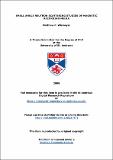Files in this item
Small angle neutron scattering studies of magnetic recording media
Item metadata
| dc.contributor.advisor | Lee, S. L. | |
| dc.contributor.author | Wismayer, Matthew P. | |
| dc.coverage.spatial | xxxii, 271 | en |
| dc.date.accessioned | 2008-05-08T15:26:00Z | |
| dc.date.available | 2008-05-08T15:26:00Z | |
| dc.date.issued | 2008-06-24 | |
| dc.identifier.uri | https://hdl.handle.net/10023/471 | |
| dc.description.abstract | In the beginning of the twenty-first century, educational and commercial institutions have driven the demand for cheap and efficient data storage. The storage medium known as magnetic recording media has remained the mainstay for most computer systems due to its large storage capacity per dollar. With the recording media's ever-increasing storage density has come reductions in the magnetic grain size per bit. At the recording bit's density threshold, the magnetic grains become more susceptible to thermal activation, which can render the storage medium unusable. An accurate characterisation of the recording layer's sub-granular structure is essential for understanding the magnetic and thermal mechanisms of high-density recording media. Small-Angle Neutron Scattering (SANS) studies have been performed to investigate the magnetic and physical properties of longitudinal and perpendicular recording grains. The SANS studies of longitudinal magnetic recording media have probed the recording layer's magnetic grain size at a sub-nanometer resolution. In conjunction with these studies, SQUID magnetometry was used to characterise the recording grain's bulk magnetism. Measurements showed that the recording grain was composed of a ferromagnetic hard core (Co-enriched) and a weakly magnetic shell (Cr-enriched). These results provided important information on the grain's magnetic anisotropy, which determines the recording media's magnetic stability. The polarised SANS studies were used to characterise the recording layer's physical granular structure. It was shown that the physical grain size was comparable to its magnetic counterpart. These physical measurements provided insight into the recording grain's chemical composition. The magnetic properties of perpendicular magnetic recording media were studied using SANS and VSM measurements. The neutron scattering studies revealed that the recording grain was composed of a hard ferromagnetic centre enriched with cobalt. The VSM studies showed that the magnetic recording grains exhibited a large perpendicular magnetic anisotropy. These combined studies provided information on the recording grain's ferromagnetic composition and magnetic stability. The polarised SANS measurements showed the physical grain size to be slightly smaller than its magnetic counterpart. This size difference was attributed to the non-magnetic grain boundary composed of SiO2. The boundary thickness determined the degree of inter-granular exchange coupling. Further polarised studies investigated the recording layers switching behaviour, which revealed more information on the grain's magnetic stability. | en |
| dc.format.extent | 61927413 bytes | |
| dc.format.mimetype | application/pdf | |
| dc.language.iso | en | en |
| dc.publisher | University of St Andrews | |
| dc.rights | Creative Commons Attribution-ShareAlike 3.0 Unported | |
| dc.rights.uri | http://creativecommons.org/licenses/by-sa/3.0/ | |
| dc.subject | Data storage | en |
| dc.subject | Thermal activation | en |
| dc.subject | Longitudinal | en |
| dc.subject | Perpendicular | en |
| dc.subject | SANS | en |
| dc.subject | Magnetometry | en |
| dc.subject | Anisotropy | en |
| dc.subject | Exchange | en |
| dc.subject.lcsh | Magnetic recorders and recording--Materials | en |
| dc.subject.lcsh | Magnetic materials | en |
| dc.subject.lcsh | Neutrons--Scattering | en |
| dc.subject.lcsh | Small-angle scattering | en |
| dc.subject.lcsh | TK7881.6W5 | |
| dc.title | Small angle neutron scattering studies of magnetic recording media | en |
| dc.type | Thesis | en |
| dc.type.qualificationlevel | Doctoral | en |
| dc.type.qualificationname | PhD Doctor of Philosophy | en |
| dc.publisher.institution | The University of St Andrews | en |
| dc.publisher.department | School of Physics and Astronomy | en |
This item appears in the following Collection(s)
Except where otherwise noted within the work, this item's licence for re-use is described as Creative Commons Attribution-ShareAlike 3.0 Unported
Items in the St Andrews Research Repository are protected by copyright, with all rights reserved, unless otherwise indicated.


